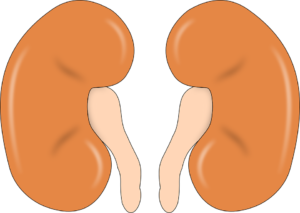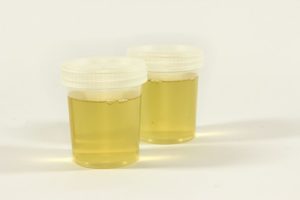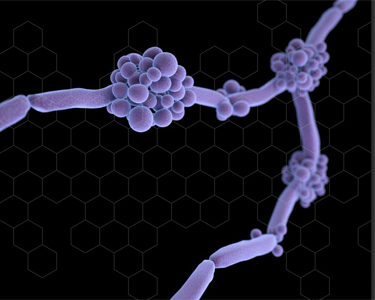The following is a clinical review written by Allison Graner, UNMC College of Pharmacy PharmD candidate 2019, and supervised by Scott Bergman PharmD FIDSA, Clinical Pharmacy Coordinator of Nebraska Medicine Antimicrobial Stewardship Program
What is the appropriate treatment for urinary tract infection caused by Candida glabrata?
Infections caused by the fungus known as Candida, the most common fungus to be cultured in the microbiology lab encompass many different species. Candida spp are part of the human natural flora, and just because they are detected in a sample does not mean they are pathogenic. The most common Candida species is Candida albicans, and this organism fortunately has very low resistance rates against antifungals. Candida glabrata, however, exhibits resistance around 30% of the time to azole antifungals.1 In many infections the inability to use a drug such as fluconazole does not pose a problem because another class of antifungals, the echinocandins, is a dependable group of medications that has strong fungicidal activity against Candida glabrata.2 However, candiduria is unlike most infections because most antifungal drugs do not reach the urine in high enough concentrations.
Candida in a urine sample does not always mean the patient needs to start therapy to eradicate the yeast. In an asymptomatic patient, this indicates colonization and does not need to be treated. In fact, treatment is not recommended unless the patient is neutropenic, will need urologic surgery, or is a very low-birth-weight infant, all of which meet criteria for high-risk patients.3 If Candida is present, it is suggested that the medical team look for causes of why this could be, as it is usually associated with catheter use, diabetes mellitus, or patients who are immunosuppressed. Regardless of the cause, if the candiduria is causing symptoms, spreading to other sites of the body, or the patient is clinically worsening, appropriate treatment is necessary.1,3
Azole Antifungals
Due to its high penetration into the urine, the number one drug for Candida-associated urinary tract infections (UTI) is fluconazole for 14 days.3 Treating candiduria with amphotericin B bladder irrigation used to be a more common therapeutic option, and there was originally concern for treating a localized infection with a systemic medication such as fluconazole. However, a randomized, double-blinded study concluded that fluconazole is at least as effective as amphotericin B irrigation, but less expensive and causes fewer side effects.4
 Fluconazole is 100% bioavailable when given intravenously or orally. It is also renally eliminated with almost 80% of the drug remaining unchanged upon excretion into the urine. When comparing concentrations in the plasma to that in the urine, urine levels exceed plasma by 10 times the amount.5 This means that lower doses could be used to achieve eradication of the infecting organism when it is in the urine. Fluconazole also penetrates the kidney tissue, making it even more optimal in cases of pyelonephritis.5
Fluconazole is 100% bioavailable when given intravenously or orally. It is also renally eliminated with almost 80% of the drug remaining unchanged upon excretion into the urine. When comparing concentrations in the plasma to that in the urine, urine levels exceed plasma by 10 times the amount.5 This means that lower doses could be used to achieve eradication of the infecting organism when it is in the urine. Fluconazole also penetrates the kidney tissue, making it even more optimal in cases of pyelonephritis.5
However, Candida glabrata exhibits fluconazole resistance rates up to 30%. Sometimes this can be overcome with the concept of susceptible but dose-dependent therapy, but other therapeutic options may need to be considered.1 In symptomatic candiduria caused by Candida glabrata, consider requesting susceptibility testing. The minimum inhibitory concentration (MIC) for C. glabrata to fluconazole can range from 0.25 to 256 μg/mL. The MIC should be noted because Candida glabrata exhibits dose-dependent susceptibility at concentrations <32 μg/mL.
In Candida glabrata urinary tract infections, always consider fluconazole as a first line option when MIC is <8 μg/mL. An oral dose of 200-400 mg per day would be adequate since urine drug concentrations are substantially higher than blood levels. Even with an MIC up to 64 ug/mL, fluconazole therapy should be considered because the urine concentration of the drug would result in levels >100 μg/mL, given its ability to easily penetrate the urine.1 With any MIC greater than this, the clinician should explore other therapeutic options since the minimum Inhibitory concentration would then exceed that of the amount of drug able to access the urine. Drug interactions need to be monitored, along with signs of hepatotoxicity and the QT interval of the patient. A different azole antifungal is not an option, as no other drug in this class has adequate distribution into the urine.1
Echinocandins
 Echinocandins are an acceptable alternative option, though they may not penetrate the urine at high levels. To date, 10 successful case studies have been published, 6 with caspofungin and 4 with micafungin, which have laid a foundation for the use of these medications in UTIs. The case reports with Micafungin used doses from 50 mg to 200 mg daily for 14 to 25 days, and all showed benefit. Micafungin has poor glomerular filtration and tubular secretion, however, a small percentage still makes its way into the urine as unchanged drug.6 In animal studies, micafungin was found to concentrate in the kidney tissue at 1.6 times the amount in the plasma, which could be beneficial in the case of pyelonephritis. Studies have shown that with a dose of micafungin 100 mg, the maximum plasma concentration averages almost 6 μg/mL. Even with only 1% of the drug reaching the urine, about 0.06 μg/mL of micafungin in the urine could exceed the MIC of Candida glabrata to micafungin, which is usually very low (MIC ≤ 0.015 to 0.5 μg/mL).6
Echinocandins are an acceptable alternative option, though they may not penetrate the urine at high levels. To date, 10 successful case studies have been published, 6 with caspofungin and 4 with micafungin, which have laid a foundation for the use of these medications in UTIs. The case reports with Micafungin used doses from 50 mg to 200 mg daily for 14 to 25 days, and all showed benefit. Micafungin has poor glomerular filtration and tubular secretion, however, a small percentage still makes its way into the urine as unchanged drug.6 In animal studies, micafungin was found to concentrate in the kidney tissue at 1.6 times the amount in the plasma, which could be beneficial in the case of pyelonephritis. Studies have shown that with a dose of micafungin 100 mg, the maximum plasma concentration averages almost 6 μg/mL. Even with only 1% of the drug reaching the urine, about 0.06 μg/mL of micafungin in the urine could exceed the MIC of Candida glabrata to micafungin, which is usually very low (MIC ≤ 0.015 to 0.5 μg/mL).6
Caspofungin data suggests effective use despite only 2-3% of active drug reaching the urine.8 However, data from a randomized double-blind trial proved micafungin was just as effective as caspofungin and had a similar side effect profile for invasive infections. Micafungin does not require a loading dose, is less expensive and therefore is preferred at most institutions.2 Micafungin is the most cost effective option, but in a setting where micafungin is unattainable, caspofungin would be an appropriate therapeutic option.
Other Antifungals
The Candida guidelines recommended using amphotericin B at 0.3–0.6 mg/kg daily for 1 to 7 days or flucytosine 25mg/kg 4 times daily for 7 to 10 days if unable to utilize fluconazole. For urinary tract infections, the amphotericin B deoxycholate formulation must be used as the liposomal product will not reach the urine in high enough concentrations. Amphotericin B deoxycholate is known for the intolerablility of its adverse events.9 For UTIs caused by Candida, it is also used to directly irrigate the bladder. This method is effective in up to 90% of patients, but long term efficacy has not been proven, as many patients have recurrent candiduria within weeks.3 If not for its side effects and cost, flucytosine would be a great option as 97% is excreted as unchanged drug into the urine, and it has low resistance rates against most Candida species.3,5 However, resistance can develop when using flucytosine alone for more than a few days. In severe infections it is often paired with amphotericin B to prevent the resistance from developing.3
 With the already mentioned therapeutic options being readily available, these agents are only used in refractory cases in the United States because of their cost and toxicities. Flucytosine was developed as a chemotherapy agent, and can predictably cause side effects such as bone marrow suppression, hepatotoxicity, gastrointestinal problems, rash, and diarrhea.1 After a recent price hike in the US, using flucytosine would cost around $1400 per day.10 Amphotericin B also has a long list of adverse events such as renal toxicity, electrolyte abnormalities, hypotension, chills, headaches, etc., and can cost anywhere from $90 to $160 per day.9
With the already mentioned therapeutic options being readily available, these agents are only used in refractory cases in the United States because of their cost and toxicities. Flucytosine was developed as a chemotherapy agent, and can predictably cause side effects such as bone marrow suppression, hepatotoxicity, gastrointestinal problems, rash, and diarrhea.1 After a recent price hike in the US, using flucytosine would cost around $1400 per day.10 Amphotericin B also has a long list of adverse events such as renal toxicity, electrolyte abnormalities, hypotension, chills, headaches, etc., and can cost anywhere from $90 to $160 per day.9
Conclusion:
Fluconazole has established efficacy for its use in candiduria, and if following susceptibility testing the Candida species is susceptible (or dose dependent), fluconazole for 14 days should be considered the number one therapeutic option. If the organism is resistant or fluconazole is not an option, consider antifungals from the echinocandin class, as more case reports are demonstrating efficacy despite minimal urine penetration. If all of the above options are unavailable, one could then consider therapy with amphotericin B or flucytosine knowing that more toxicities are probable and the expense will be higher.
References:
- Fisher JF, Sobel JD, Kauffman CA, et al. Candida Urinary Tract Infections – Treatment. Clinical Infectious Diseases. 2011;52(S6):S457-S466.
- Pappas PG, Rotstein CMF, Betts RF, et al. Micafungin versus Caspofungin for Treatment of Candidemia and Other Forms of Invasive Candidiasis. Clinical Infectious Diseases. 2007;45:883-893.
- Pappas PG, Kauffman CA, Andes DR, et al. Clinical Practice Guideline for the Management of Candidiasis: 2016 Update by the Infectious Diseases Society of America. Clinical Infectious Diseases. 2015 November:1-50.
- Sobel JD, Kauffman CA, McKinsey D, et al. Candiduria: A Randomized, Double-Blind Study of Treatment with Fluconazole and Placebo. Clinical Infectious Diseases. 2000;30:19-24.
- Felton T, Troke PF, Hope WW. Tissue Penetration of Antifungal Agents. Clinical Microbiology Reviews. 2014; 27:68-88.
- Pieralli F, Bazzini C, Vannucchi V, et al. A case of candida glabrata severe urinary sepsis successfully treated with micafungin. Medical Mycology Case Reports. 2015;5:1-3.
- Fisher JF, Woeltje K, Espinel-Ingroff A, et al. Efficacy of a single intravenous dose of amphotericin B for Candida urinary tract infections: further favorable experience. Clinical Microbiology Infections. 2003;9:1024-1027.
- Sobel JD, Bradshaw SK, Lipka CJ, et al. Caspofungin in the Treatment of Symptomatic Candiduria. Clinical Infectious Diseases. 2007;44:e46-e49.
- Drew R. (2018). Pharmacology of amphotericin B. Retrieved September 14, 2018, from https://www-uptodate-com.library1.unmc.edu/contents/pharmacology-of-amphotericin-b
- Drew RH, Perfect JR (2018). Pharmacology of flucytosine. Retrieved September 14, 2018.
Featured image from CDC: https://www.cdc.gov/fungal/antifungal-resistance.html

Allison Graner, UNMC College of Pharmacy PharmD candidate 2019

I appreciate the information in this article about C. glabrata. I recently got results from one of my patients + for this type of yeast.